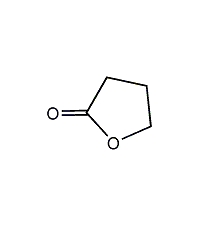
Structural formula
| Business number | 02B7 |
|---|---|
| Molecular formula | C4H6O2 |
| Molecular weight | 86 |
| label |
4-butyrolactone, 4-Hydroxybutyrolactone, 1,4-butyrolactone, 1,4-Butyrolactone, 4-Hydroxybutyric acid lactone, 4-Hydroxybutanoic acid lactone, 4-Butanolide, Ester cyclic compounds and their derivatives |
Numbering system
CAS number:96-48-0
MDL number:MFCD00005386
EINECS number:202-509-5
RTECS number:LU3500000
BRN number:105248
PubChem number:24901615
Physical property data
1. Properties: Colorless to yellow oily liquid with a cream-like aroma.
2. Relative density (15℃): 1.1286
3. Relative vapor density (g/mL, air=1): 3.0
4. Melting point (ºC): -44
5. Boiling point (ºC, normal pressure): 206
6. Viscosity (mPa·s, 25ºC): 1.7
7. Refractive index (26.5ºC): 1.4343
8. Flash point (ºC): 99.2
9. Autoignition point or ignition temperature (ºC): 455
10. Vapor pressure (mmHg, 20ºC): 1.5
11. Saturated vapor pressure (kPa, 20ºC): 2.0
12. Heat of evaporation (KJ/mol, 204ºC ): 52.3
13. Critical temperature (ºC): 457.85
14. Critical pressure (KPa): 5.131
15. Specific heat capacity (KJ/(kg ·K), 25ºC, constant pressure): 1.67
16. Specific heat capacity (KJ/(kg·K), 60ºC, constant pressure): 1.88
17. Explosion upper limit (% , V/V): 16
18. Lower explosion limit (%, V/V): 1.4
19. Solubility: miscible with water, also soluble in methanol and ethanol , ether, benzene and other organic solvents.
20. Relative density (20℃, 4℃): 1.1299
21. Refractive index at room temperature (n20): 1.4346
22. Refractive index at room temperature (n25): 1.4348
23. Solubility parameter (J·cm-3)0.5 : 25.593
24. van der Waals area (cm2·mol-1): 6.250×109
25. van der Waals Volume (cm3·mol-1): 45.890
26. Liquid Phase standard hot melt (J·mol-1·K-1): 140.0
Toxicological data
1. Acute toxicity: oral administration – rat LD50: 1540 mg/kg; oral administration – mouse LD50: 1720 mg/kg
2. It is of low toxicity. Irritating to skinand acetic acid at 120°C, catalyzed by MPa and manganese acetate or manganese dioxide, to produce finished products.
8. β-Formylpropionate method β-Formylpropionate is obtained by hydrogenation reduction, hydrolysis, dehydration and cyclization.
Refining method: dry anhydrous calcium sulfate and then fractionate. It can also be refined by steam distillation.
9. Tobacco: FC, 9, 18, 40; BU, OR, 40; intramolecular esterification of γ-hydroxybutyric acid; produced from vinyl acetic acid; produced from 1,4-butanediol Prepared by dehydrogenation; produced from maleic anhydride, with tetrahydrofuran as a by-product.
10. Preparation method:
In a reaction flask equipped with a stirrer, reflux condenser (connected to a gas pipe to the hydrogen chloride absorption device), thermometer, and dropping funnel, add chloroform 250mL, 250g (1.88mol) anhydrous aluminum trichloride, stir to form a suspension. Slowly add a mixture of 42.5g (0.528mol) chloroethanol and 80g (0,5mol) diethyl malonate (2) dropwise, and complete the addition in about 2 hours. Hydrogen chloride gas is continuously produced during the reaction. Leave overnight. Under cooling in an ice-water bath, slowly add 250 mL of 2 mol/L hydrochloric acid dropwise to decompose the reaction solution, and generate hydrogen chloride gas at the same time. After the addition is completed, the temperature is slowly raised and the reaction is refluxed for 40 hours. Separate the brown-red chloroform liquid (retain the aqueous layer), and dissolve the solid in 150 mL of water. The aqueous layers were combined and extracted three times with chloroform. Combine the chloroform layers, wash with water until neutral, and dry over anhydrous calcium chloride. Chloroform was distilled off, and then distilled under reduced pressure. The fractions at 85-100°C/1.05kPa were collected to obtain 36g of γ-butyrolactone (1), with a yield of 82%. [1]
Purpose
Used for gas chromatography stationary solution (maximum operating temperature 30°C, solvent is methanol). Separate and analyze hydrocarbons, various oxygen-containing compounds, and permanent gases. Synthesize intermediates such as polyvinylpyrrolidone, DL-methionine, hexahydropyridine, phenylbutyric acid and thioacetic acid. Solvent for polyacrylonitrile, acetate, polymethylmethacrylate and polystyrene. It is also an ideal antioxidant, plasticizer, extractant, absorbent, dispersant, fixative, and coagulant; it can be used as an anesthetic and sedative in the pharmaceutical industry, and can be used to synthesize ciprofloxacin and interferon, etc. It is an intermediate for vitamins, cyclopropylamine, etc.; it is also widely used in agriculture and forestry, and is an intermediate for the production of plant growth agents, pesticides, etc. In addition, it can also be used for making batteries, capacitors, color rolls, etc. γ-Butyrolactone is a high-boiling point solvent with strong solubility, non-toxicity, safe and convenient use and management. It is used as an extraction agent for butadiene, aromatic hydrocarbons and high-grade greases in petroleum processing; it is also used in the chemical fiber industry. It is a spinning solvent for acrylic fiber and a dyeing auxiliary for wool, nylon, acrylic and other fibers. In organic synthesis, GBL is also widely used. It is a raw material for the synthesis of α-pyrrolidone, N-methylpyrrolidone, vinylpyrrolidone, acetyl-γ-butyrolactone, cyclopropylamine, etc. It is also a raw material for the synthesis of pesticides and herbicides. Intermediates of agents, drugs Naofukang, ciprofloxacin, vitamin B1, chlorophyll, etc. It is also used in the synthesis of chlorophenoxybutyric acid herbicides and plant growth regulators. Used as a plasticizer for epoxy resin adhesives and also as a solvent. It is widely used as a solvent for resins, high molecular polymers, petroleum products, coatings, inks, dyes and agricultural chemicals. It is also used as lubricating oil additive, dyeing auxiliary, fuel oil viscosity regulator, acrylic fiber coagulant, photographic agent dispersant, thickener, aromatic hydrocarbon extractant and conductive solvent. In organic synthesis, it is used to manufacture 2-pyrrolidone, N-methyl-2-pyrrolidone, polyvinylpyrrolidone and butyric acid, etc. In the food industry, it can be used as a clarifying agent for liquor and beer and for preparing fruit and meat flavors.

 微信扫一扫打赏
微信扫一扫打赏

